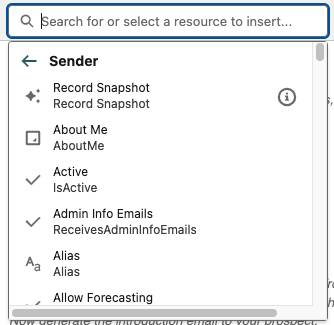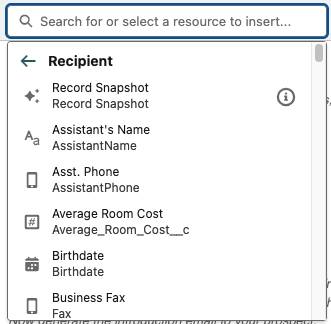Create and Ground Prompt Templates
Learning Objectives
After completing this unit, you’ll be able to:
- Describe what grounding is.
- Use Prompt Builder to create a sales email prompt template.
- Add resources to a prompt template.
- Use an Apex class to provide data to a prompt template.
Trailcast
If you'd like to listen to an audio recording of this module, please use the player below. When you’re finished listening to this recording, remember to come back to each unit, check out the resources, and complete the associated assessments.
The Why and the How
In the Prompt Builder: Quick Look module, Linda Rosenberg, a Salesforce admin, aimed to reduce her sales team's manual workload by automating tasks with prompt templates. In this module, we take a deeper dive and show you why and how she did it.
Build a Sales Email Prompt Template
Linda needs to create a template that her sales team can use to generate emails. She wants to reduce the time that the team spends on creating invitations to customers for product events.
To do this, Linda navigates to Prompt Builder in Salesforce Setup. When she navigates to Prompt Builder, the first page that’s shown is the Prompt Builder Explore page. Here you find:
- Guidance to help you learn more about the features of Prompt Builder.
- Access to prompt template walkthroughs and examples.
- A listing of all existing prompt templates with their type, category and status.
- Functionality to edit and delete existing prompt templates.
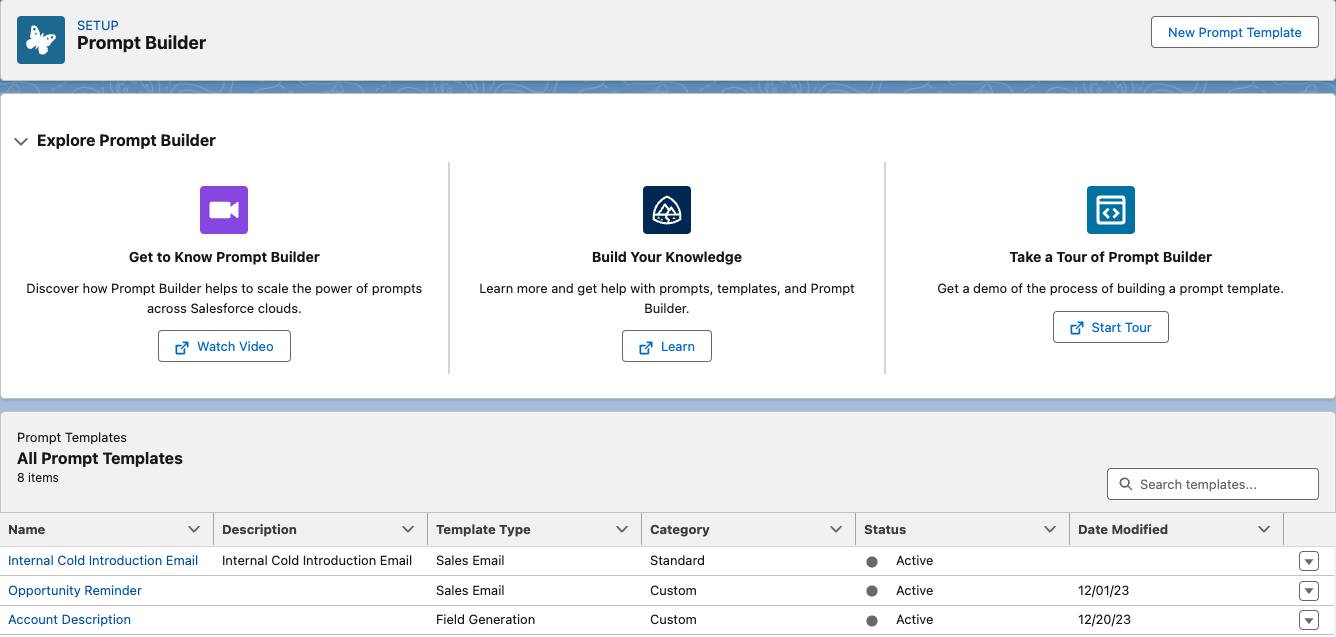
From the Explore page, Linda can also create a prompt template. She clicks the New Prompt Template button.
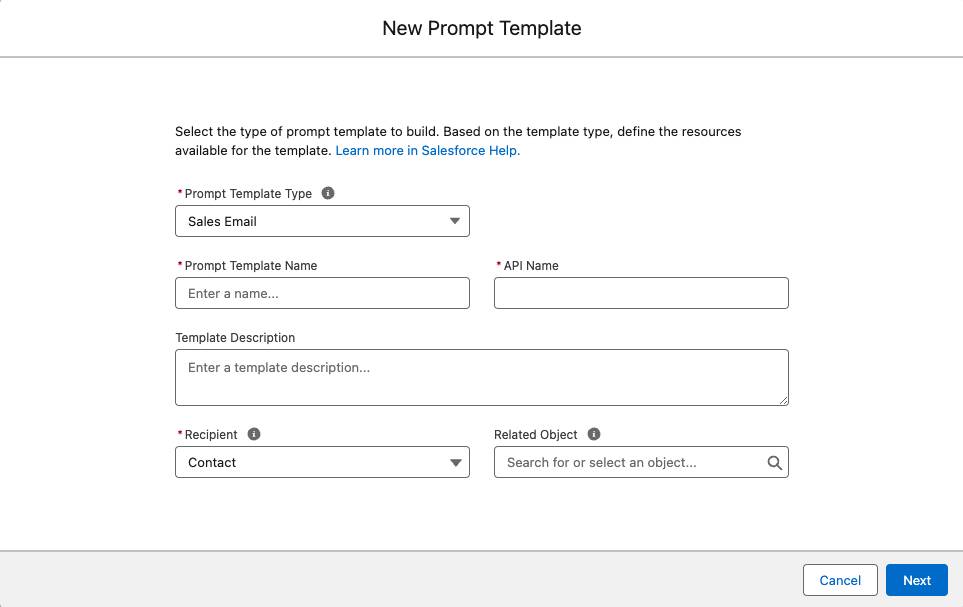
Linda starts to complete the fields in the template type setup screen.
When you set up a prompt template, it’s important to have a clear goal. In this case, Linda must think about who her company’s customers are and what the sales team wants them to see in the email.
Linda understands that her email may be sent to any Cloud Kicks contact. Therefore, Contact is the recipient object. She completes the template type setup by selecting:
- Prompt Template Type: Sales Email
- Prompt Template Name:
Invite Customer to Local Product Event - API Name:
Invite_Customer_to_Local_Product_Event - Template Description:
Email customer to invite to local product event. - Recipient: Contact
- Related Object: Account
Ground Your Template
Making templates specific makes them effective. Another way of saying “specific” is to say your template is grounded.
Once Linda has defined her template type, she begins drafting and grounding her prompt in the Prompt Template Workspace.
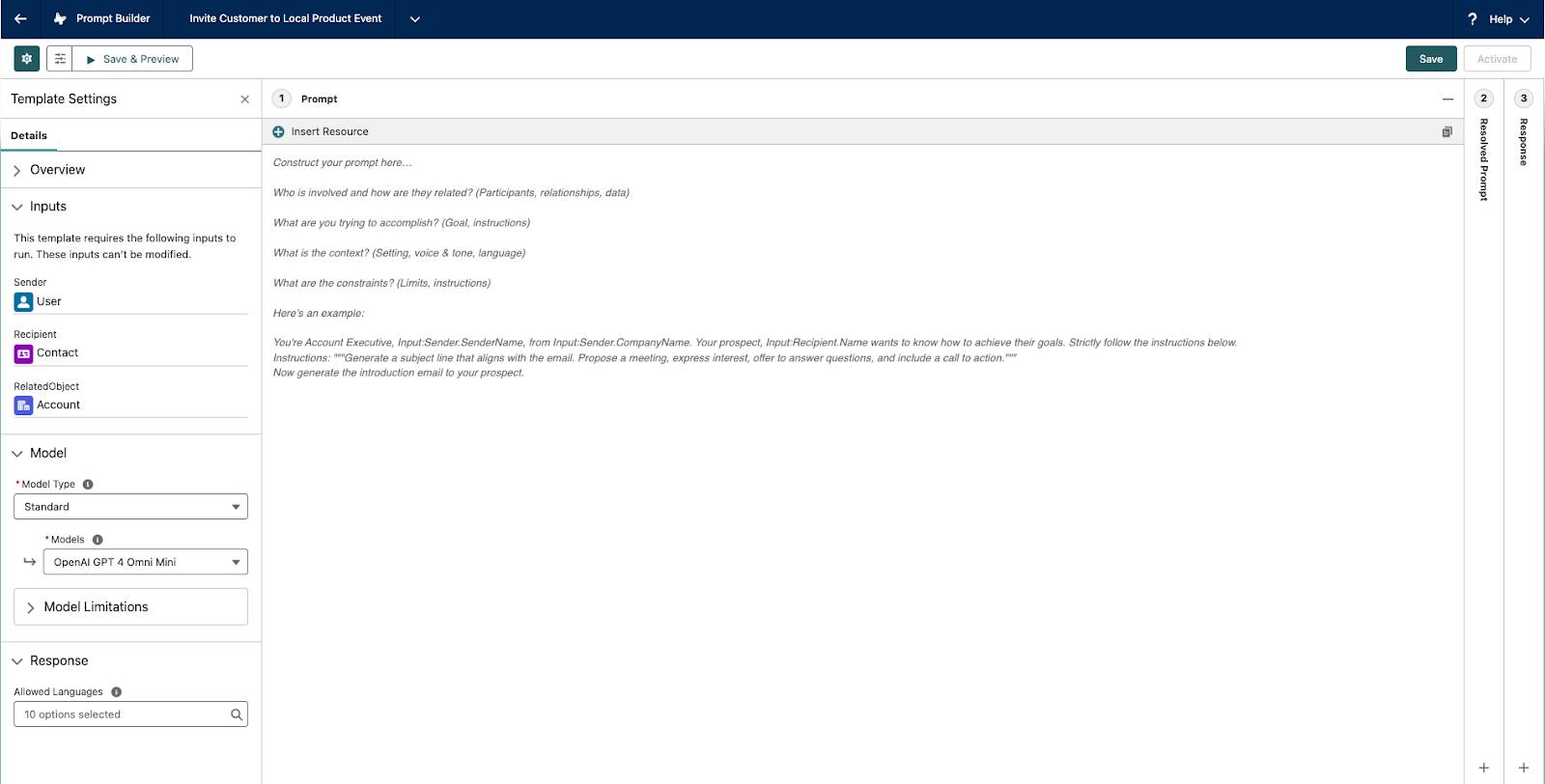
Linda includes the customer name, who the email is from, their titles, and details about the event.
|
You are a Salesforce admin and your name is Linda Rosenberg from the organization Cloud Kicks. Your prospect is Rob Hutchinson, a director from Acme Inc., and they are based in Toronto, Ontario. In the email, invite the prospect to attend the event “Floating on Clouds: Toronto Kickoff” on September 18, an event for customers of Cloud Kicks new and old to network and preview upcoming products, in no more than 70 words. Explain to the prospect the possible benefits of attending the event and mention that you would be happy to chat with them further at the event or online if they need more information. |
|---|
The prompt looks great. However, her first draft is hard-coded for only one specific sender and recipient. That would be okay if the prompt is going to be used once. But the concept of a prompt template is that it can be used for any sender and recipient. What she needs is a way to get her company’s CRM data into the template and ground it automatically.
Happily, Linda knows that she can use merge fields, Apex, and Flow as resources to enable Prompt Builder to securely access Salesforce data.
Add Merge Fields to a Prompt Template
Linda reviews her prompt and looks for areas where she can use merge fields to take her prompt from hardcoded for one-time use to reusable for any sender and recipient.
|
You are a Salesforce admin and your name is Linda Rosenberg from the organization Cloud Kicks. Your prospect is Rob Hutchinson, a director. They are based in Toronto, Ontario. In the email, invite the prospect to attend the event “Floating on Clouds: Toronto Kickoff” on September 18, an event for customers of Cloud Kicks new and old to network and preview upcoming products, in no more than 70 words. Explain to the prospect the possible benefits of attending the event and mention that you would be happy to chat with them further at the event or online if they need more information. |
|---|
Within the Prompt Template Workspace, Linda uses the Resources picklist to choose the type of resource to use. She sees there are multiple options for sales email prompt templates. Current Organization, Sender, and Recipient are all available to use in her prompt template.
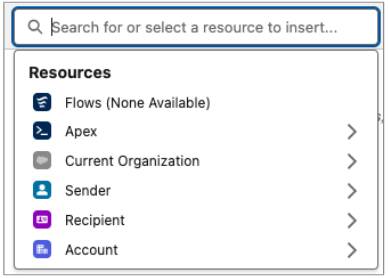
In the Resources picklist, Linda selects Sender and Recipient, where she then selects specific information, like title, name, company, and so on to ground her prompt template. She saves her work.
|
|
|---|
|
You are a In the email, invite the prospect to attend the event "Floating on Clouds: Toronto Kickoff" on September 18, an event for customers of Cloud Kicks new and old to network and preview upcoming products, in no more than 70 words. Explain to the prospect the possible benefits of attending the event and mention that you would be happy to chat with them further at the event or online if they need more information. |
|---|
After she’s done, she notices there’s one piece of her prompt that needs an adjustment before it can display the correct response: "Floating on Clouds: Toronto Kickoff" on September 18.
At Cloud Kicks, “Floating on Clouds” is a nationwide event that hosts local customers based on their city. Linda wants to make sure the sales email prompt template is as personalized as possible and generates emails that invite customers to local events.
Linda understands that using only merge fields for this portion isn't enough. She needs logic incorporated into her prompt template. There are several approaches to accomplish this within Prompt Builder, including using Apex or Template-Triggered Prompt Flows. First, let’s explore how to use Apex in prompt templates.
Add Apex to a Prompt Template
If you want to use data from a SOQL query or an external API in your prompt, consider Apex. Apex is also effective if you want to generate well-formatted JSON or do programmatic data filtering.
In this case, Linda wants to create an Apex class that finds events that are close to a given contact and returns the name of the event, subject, location, and start time. Using the Developer Console she creates a class named ContactEvents with a method annotated as InvocableMethod. The InvocableMethod must accept List<Request> where the inputs defined in the Request class match the inputs within the prompt. Also, the InvocableMethod must be labeled with the CapabilityType that matches the template type.
Once her class is created, Linda returns to the Prompt Template Workspace in Prompt Builder and notices that Apex is now a resource. She adds the Apex class by clicking Resources and selecting Apex.
|
|
|---|
|
You’re a In the email, invite the prospect to attend an event for customers of Cloud Kicks new and old to network and preview upcoming products, in no more than 70 words.Explain to the prospect the possible benefits of attending the event and mention that you would be happy to chat with them further at the event or online if they need more information. Add the following event information to the email: |
|---|
Great! Now instead of referencing one single event. Linda can rely on her Apex class to return an event close to the specified contact.

